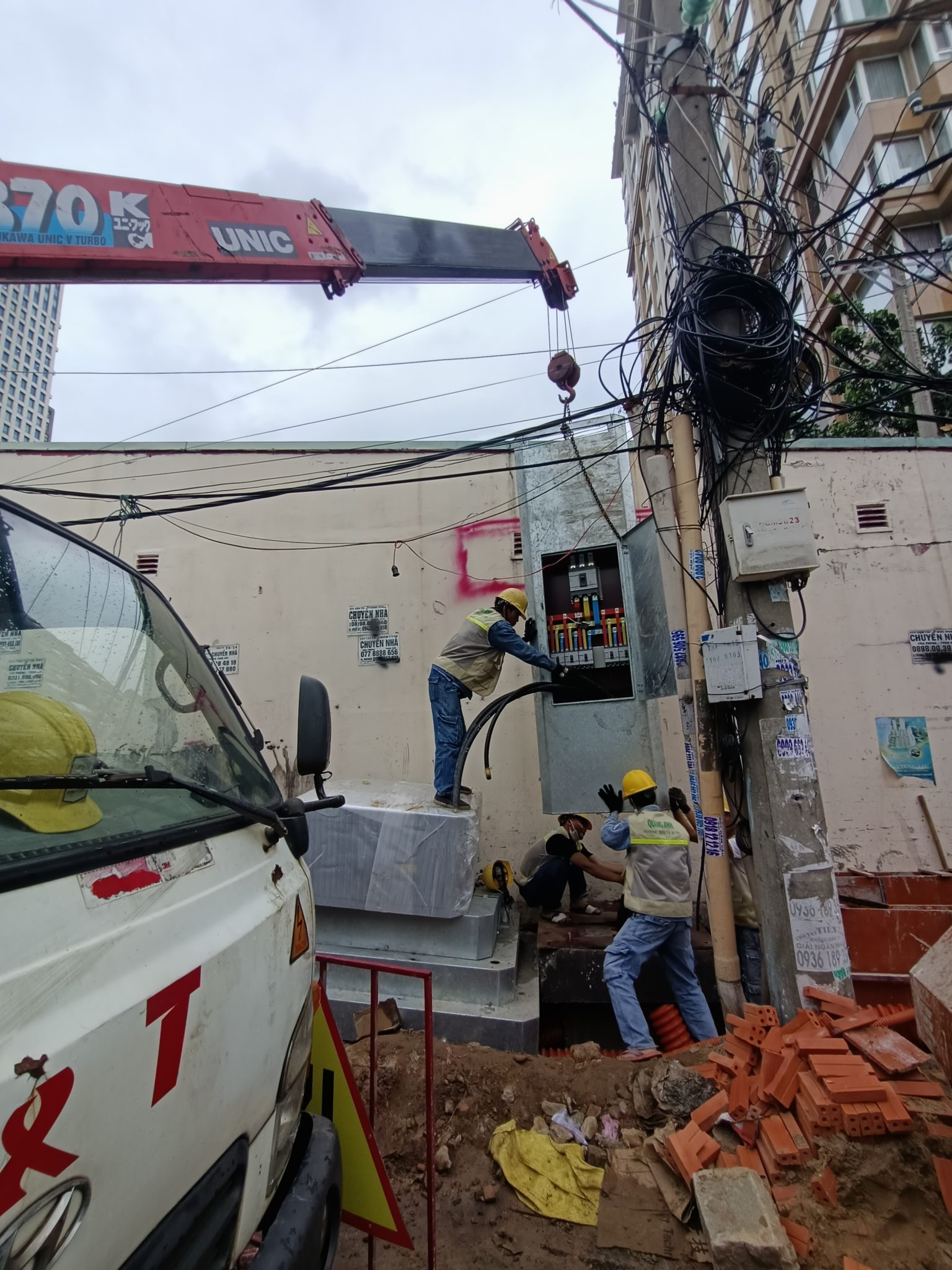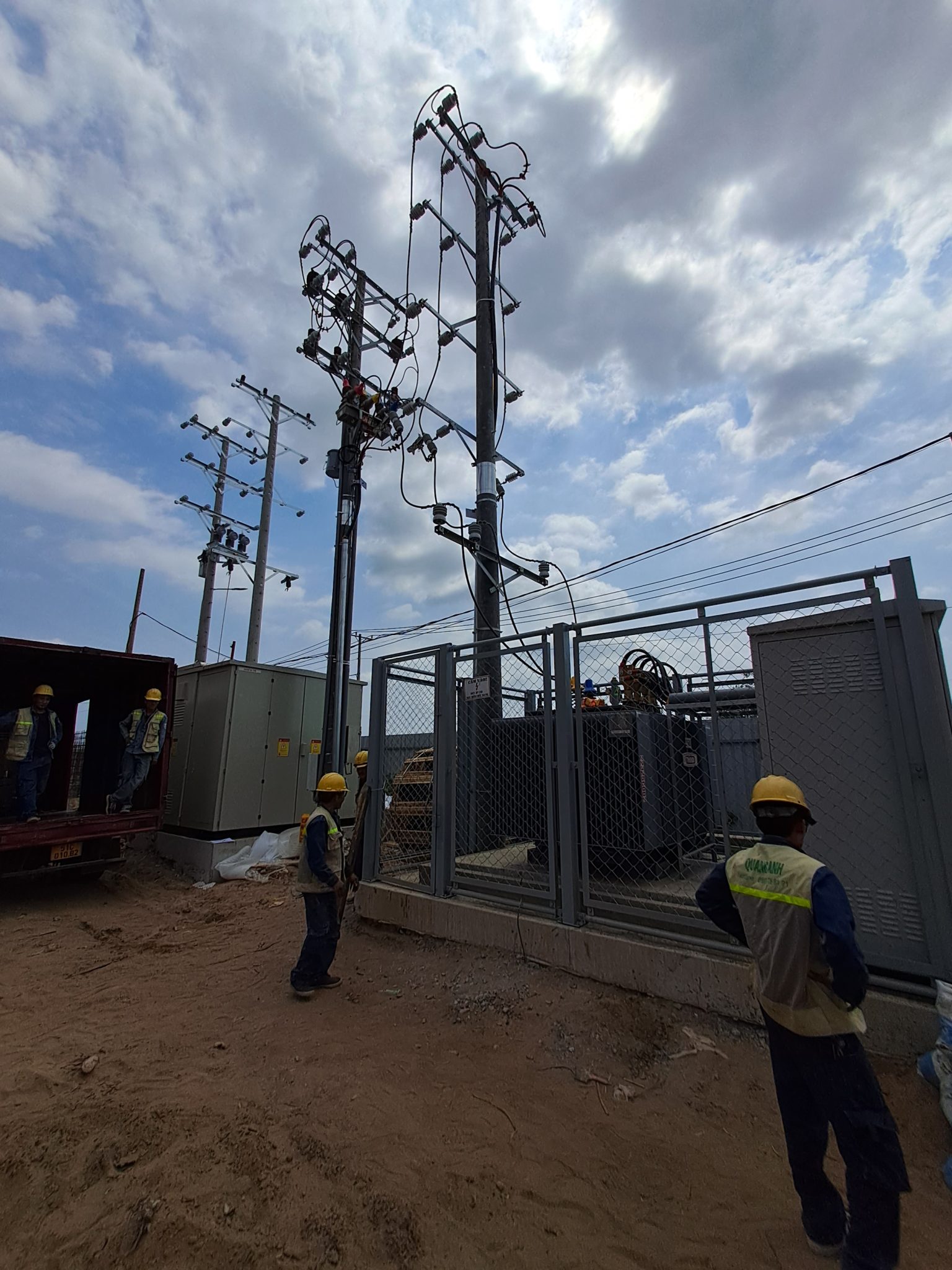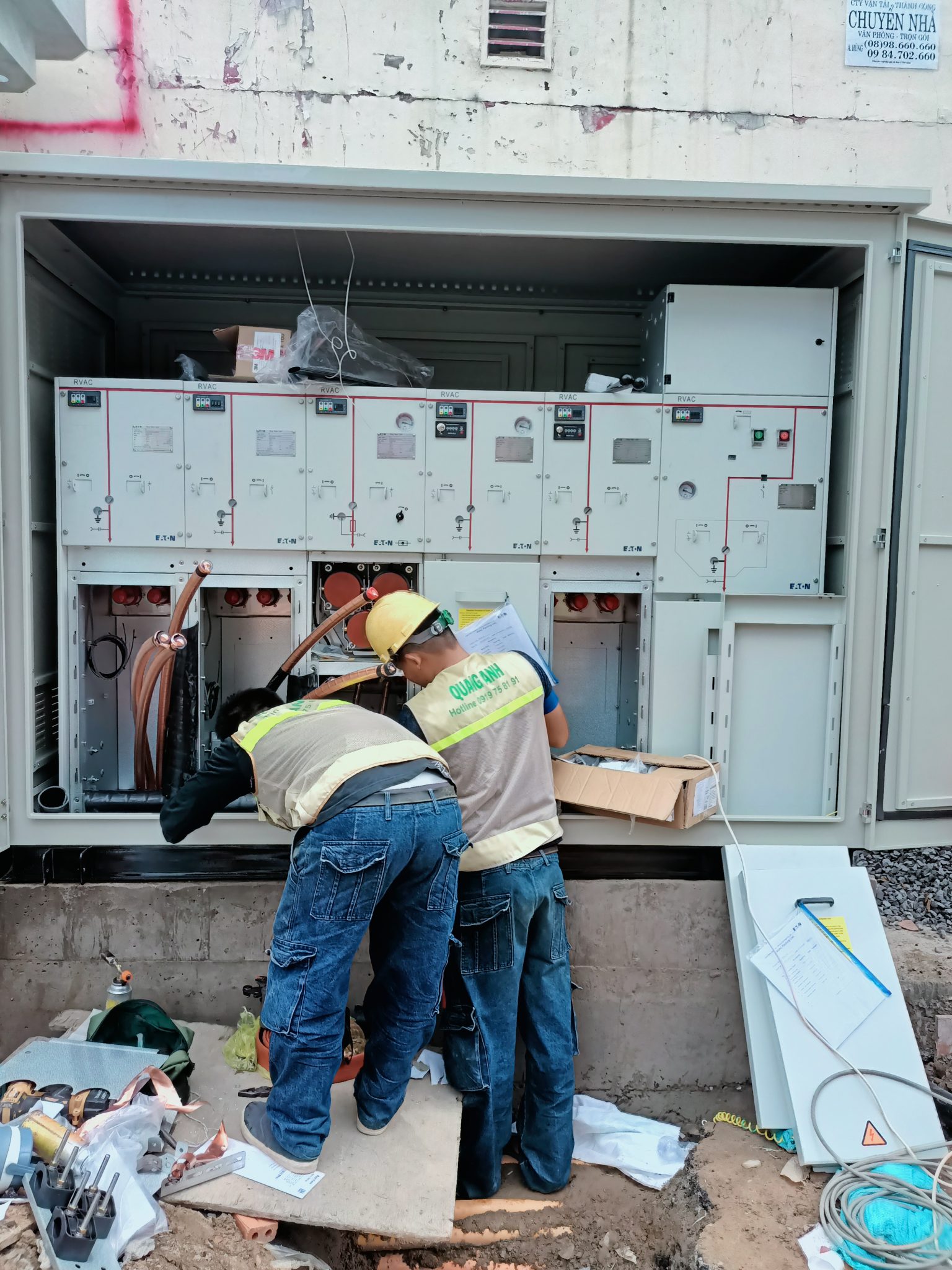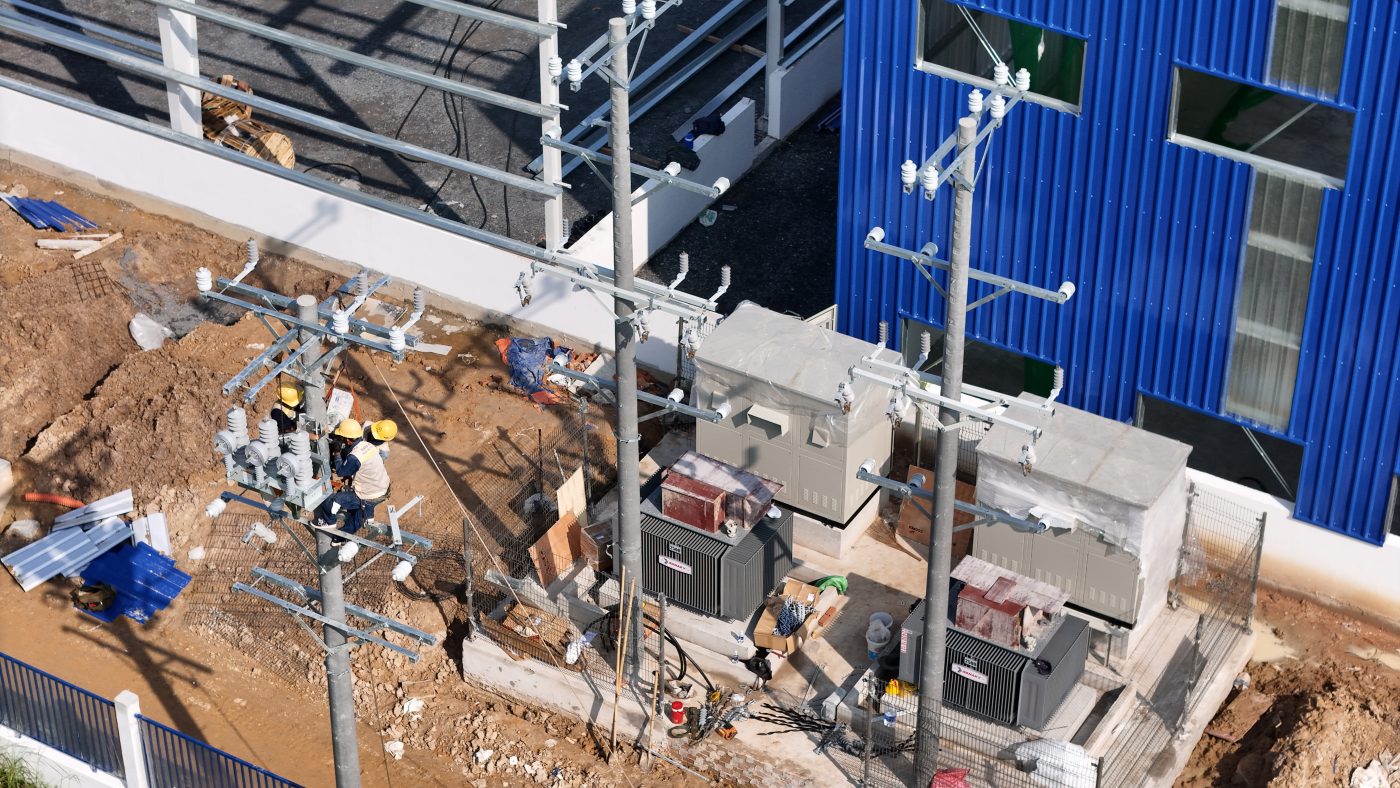Installing a factory’s electrical system is a complex process with crucial steps to ensure efficient, safe, and technically compliant operations.
Detailed Process of Factory Electrical System Installation
Starting with a detailed design and plan is essential, covering aspects like the placement of substations, electrical cabinets, cables, and devices with safety and technical standards. Following this, the installation of main power supply cables is crucial, typically connecting from the substation to the main electrical cabinet through MCCBs. This system may be designed either underground or overhead. Cable trays are then installed to organize and protect electrical cables, requiring precision to maintain neatness and prevent cable damage. Finally, industrial electrical cabinets are installed adhering strictly to technical standards for safe and effective power distribution.
1. Survey and Design
- Site Survey: This is a crucial step to assess the current electrical system and energy needs, allowing accurate equipment positioning and an informed approach to electrical system design.
- System Design: Creating detailed drawings with attention to power, voltage for optimal safety and performance, accommodating present energy needs with room for future expansion.
2. Equipment Preparation
- Transformers: Adjust voltage to meet requirements, using dependable brands like Thibidi and ABB for quality and reliability.
- Electrical Cabinets: Utilize cabinets from manufacturers like Schneider, Mitsubishi for optimal control and system protection.
- Cables and Conductors: Ensure appropriate selection matching power capacity needs for effective and safe transmission, a critical aspect of the main supply cable system.
3. Electrical Installation
- Main Power Supply Installation: Proper selection and installation of conductors, ensuring safety standards are met, avoiding errors and damage during operations.
- Underground Cabling: PVC pipes shield cables from environmental damage, enhancing system longevity and safety.
4. Cable Tray Installation
- Selecting Hangers: Hangers are vital to secure cable trays, ensuring stability under various conditions.
- Tray Fixing: Use specialized tools like hand grinders to securely attach trays.
- Cable Tray Tee: Prevents electrical leakage, minimizes incidents, and boosts system safety.
5. Inspection and Operation
- System Testing: Verifying that all devices are correctly installed, strictly conforming to safety standards before trial operations.
- Trial Operation: Conduct test runs to identify and promptly rectify anomalies, optimizing real-world performance.
6. Regular Maintenance
- Maintenance Scheduling: Periodic upkeep is essential to ensure systems function to standards, minimizing unforeseen breakdowns.

Key Factors in Electrical System Installation
Safety is paramount in factory electrical installations. Ensuring systems and devices follow current safety standards is necessary to safeguard workers and machinery. Furthermore, the system must be designed for maximum efficiency and productivity, maintaining stability and preventing disruptions. Strict adherence to technical installation practices by engineers is vital to continuous system operation.
Incorporating electrical systems is essential in factory construction and operation. Key factors can’t be overlooked to maintain a stable and safe system.
Accurate load determination is the initial step in factory electrical design. Calculating peak-hour power requirements ensures the system meets energy needs. During design, arranging high and low voltage networks logically with existing infrastructure is crucial.
Choosing industrial electrical equipment demands adherence to standard materials for conduits and cable trays. Reliable brands like Schneider and ABB meet quality and safety needs, protecting systems from unexpected incidents. Accessories and other materials must comply with strict construction standards to satisfy technical demands.
Compliance with state technical standards and regulations is indispensable, guaranteeing installation processes meet electrical safety benchmarks while environmental conservation is considered.
Design drawings and execution plans form the foundation of an effective electrical system. Clear, up-to-date drawings must meet current technical standards. The construction plan should detail pre-established steps, including timeframes and resources.
Ultimately, cost and performance optimization are vital goals in electrical system installations. Strategic calculations determine equipment quantities and conductor selection, ensuring high performance and cost savings.

Inspection and Approval of Factory Electrical Systems
Once installation is complete, inspecting and approving the electrical system is mandatory to ensure everything works effectively and safely. This process includes system trials, handover to the investor, and receiving client feedback. Contractors must complete all handover procedures, ensuring the electrical system meets quality and performance standards. Thorough inspection and approval guarantee safety and demonstrate project professionalism and quality.
The inspection and approval procedure in factory electrical systems ensures the project’s safety and performance. It spans from inspecting the electrical schematic to operational testing.
- Electrical System Testing: Reviewing technical drawings to certify compliance with current standards and the accurate reflection of installed equipment.
- Factory Electrical Inspection: Checking the condition and quality of electrical appliances like transformers, generators, and cabinets to affirm safety and efficacy.
- Acceptance Testing: Preliminary acceptance involves verifying input and output insulators and grounding values, ensuring all electrified components are safe before live system acceptance testing.
- Electrical Safety Standards: Ensuring systems adhere to electrical voltage, current standards, and necessary legal regulations, with an emphasis on operational safety.
- Operational Testing: Conduct trial operations to assess the practical capabilities of the system, ensuring all technical parameters are met and recorded through acceptance reports.
Acceptance testing is vital, requiring trial system operation under medium voltage lines and substations without load for the designated period, ensuring performance and consistency.
The final phase is handover approval, where the entire system is re-evaluated post-trial operation, ensuring no technical flaws and all equipment functions as required.

Installing a factory’s electrical system offers numerous strategic and technical benefits, including operational efficiency and safety. Smart investment strategies optimize costs, ensuring continuous and stable system operations.
For professional and safe electrical system installations, contact QuangAnhcons via Hotline: +84 9 1975 8191 for expert consultation.
QuangAnhcons offers factory electrical system design and installation services, guaranteeing quality while adhering to the highest safety standards. Our experienced engineering team is committed to delivering optimal solutions for your business.


Related Posts
Factory Electrical Systems: Comprehensive Design and Implementation Guide
Discover the detailed and safe process of factory electrical systems design and implementation. [...]
Oct
Blueprints Required for Factory Construction Permits
Discover the necessary blueprints in factory construction permit applications, from floor plans to electrical and [...]
Oct
What Are the Requirements for a Factory Construction Permit? A Comprehensive Guide
Explore the documentation and steps needed to secure a factory construction permit for streamlined project [...]
Oct
Factory Construction Permit Procedures in Vietnam: Essential Guidelines and Documents
Learn the procedures for securing a factory construction permit in Vietnam, focusing on document preparation [...]
Oct
Key Steps in the Factory Construction Process
Discover the essential steps and requirements for building factories. [...]
Oct
Comprehensive Electrical Substation Solutions by Quanganhcons
Discover the cutting-edge electrical substation solutions offered by Quanganhcons for industrial applications. [...]
Oct
Investment Costs for a 1MWp Solar Power System and Influencing Factors
Explore the investment costs for a 1MWp solar power system in Vietnam and the influencing [...]
Sep
QuangAnhcons: Elevating Wind Energy Solutions
Explore QuangAnhcons' leadership in wind energy and renewable solutions in Vietnam. [...]
Sep
Electrical Contractor Strategies at Becamex Industrial Park
Discover the strategic advancements and partnerships of the electrical contractor at Becamex Industrial Park. [...]
Sep
Investment Insights for 1MW Wind Energy in Vietnam: Costs and Opportunities
Discover the detailed analysis of costs and opportunities for investing in 1MW wind energy projects [...]
Sep
Advanced Electrical Installation Solutions by QuangAnhcons
Explore advanced electrical installation solutions and modern technology with QuangAnhcons. [...]
Sep
Enhancing Industrial Electrical Services with Quanganhcons
Discover Quanganhcons' expertise in industrial electrical services, offering efficient and sustainable power systems. [...]
Sep
Comprehensive MEP Solutions by QuangAnhcons: From Design to Maintenance Excellence
Discover optimal MEP solutions with QuangAnhcons, dedicated to excellence from design through maintenance. [...]
Sep
Comprehensive Electromechanical Contracting Solutions by QuangAnhcons
Explore QuangAnhcons' comprehensive services for efficient and safe energy system solutions. [...]
Sep
QuangAnhcons: Empowering Industrial Energy Solutions
Discover how QuangAnhcons delivers optimal industrial EPC solutions. [...]
Sep
Effective Industrial Construction Management and Execution
Optimize your industrial projects from design to execution with our contractor services. [...]
Sep
QuangAnhcons: Pioneers in M&E and Renewable Energy Solutions
Discover QuangAnhcons' innovative M&E services and renewable energy solutions. [...]
Sep
QuangAnhcons: Expertise and Outstanding Services in the Electrical Sector
Discover the unmatched expertise and services of QuangAnhcons, setting superior standards in the electrical contracting [...]
Sep
QuangAnhcons: Innovation and Precision in Industrial Electrical Contracting
Discover QuangAnhcons, a top contractor offering superior electro-mechanical solutions. [...]
Aug
Expert Solutions for 2x2500kVA Substation Projects with QuangAnhCons
Explore QuangAnhCons, a forefront entity in designing and constructing large industrial substations. [...]
Aug